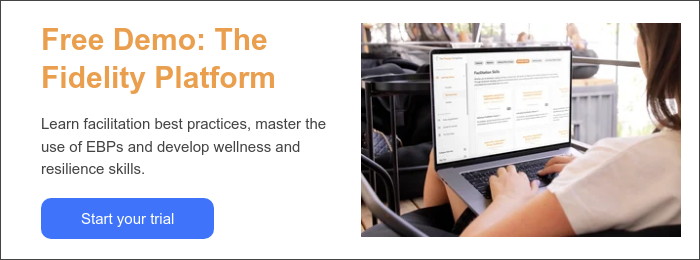“Do you feel confident about what’s happening when you’re not in the room?” This is the crucial question we ask many program administrators, clinical directors or supervisors when learning about their organizations. It's rooted in the underlying tension we’ve identified through countless conversations with our partners and thought leaders in the behavioral health field: the struggle to convert cutting-edge science and best practices into truly transformative care.
It’s no secret in the addictions community that there is a nearly two-decade gap between established best practices and what is implemented in the field. At our organization, we’ve supported tens of thousands of behavioral health professionals in adopting evidence-based practices such as motivational interviewing as well as the ASAM Criteria. These practitioners are charged with passion and a genuine drive to evoke change. However, they often grapple with “fidelity drift,” struggling to consistently implement these techniques in their interactions with clients.
A few of the recurring obstacles we encounter are:
- Fidelity drift: Much like mastering tennis doesn't come from a two-day seminar, mastering clinical skills requires continual support. To truly hone these skills, practitioners need ongoing development opportunities, robust tools, and consistent coaching and feedback.
- Insufficient resources: The diversity of issues faced by clinical staff is astounding. They are too frequently left feeling overwhelmed and underprepared, resorting to Google for answers on how to, say, “help an adolescent with a history of trauma address feelings of anger and resistance to change.” This knowledge gap lowers morale. Practitioners want to facilitate their sessions with clients but don’t always feel prepared to “author” their sessions and are left developing session plans on nights and weekends.
- Time/efficiency gap: Tailoring individual treatment plans to each client takes a lot of work, as does documenting session notes and refining treatment plans. This challenge is further amplified by the scarcity of resources, leaving many professionals feeling ill-equipped to address their clients’ needs while managing their day-to-day.

Adding to these challenges is the increased pressure to be held accountable to delivering evidence-based care and to demonstrate quantifiable results.
Our solution? At The Change Companies, we're building a scalable approach to individualized, evidence-based treatment. Our comprehensive blend of person-centered curricula, live training and online learning resources, and support technology equips our partners to:
- Customize individualized treatment programs utilizing the ASAM Criteria Dimensions and risk-need responsive frameworks. Clinicians can select from over 400 different applications of Interactive Journaling® to address the client's unique needs and recovery goals.
- Build the therapeutic alliance directly into treatment. Interactive Journaling® creates opportunities for clients to share their goals and reflect on their journey across the stages of change. This creates a jumping-off point between client and facilitator that is alliance-based and treats the individual with respect.
- Ground treatment in evidence-based practices, using our curricula as a springboard. Our curricula draw on motivational interviewing, CBT, positive psychology and the stages of change, all from a strengths-based, person-centered and positive approach.
- Use feedback and measurement to inform treatment.
In working with our partners, we have witnessed increased staff effectiveness, consistent use of evidence-based techniques and a surge in confidence when delivering individualized treatment plans. Most importantly, they are successfully empowering clients to drive positive change in their lives.
Bridging the gap begins with small steps across the chasm that produces facilitator burnout/stress, ineffective/unmeasured treatment outcomes and wasted expenditure. Let us help you take that next step wherever you are in your journey to improvement.


